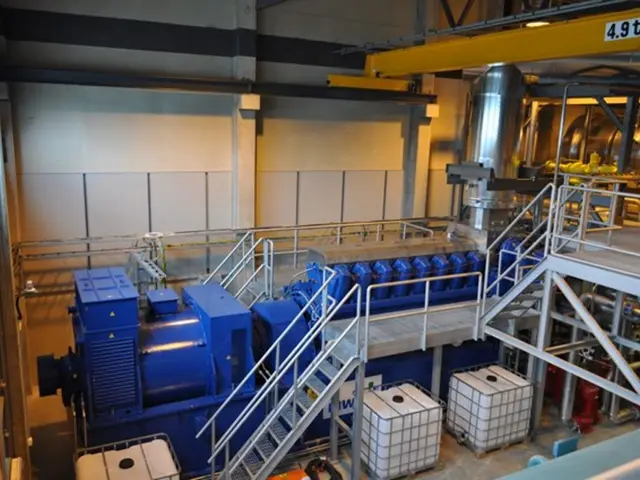Discourse Highlight: An Exclusive Interview with Claire F. Gmachl in the Realm of Research Findings
Professor Claire Gmachl, a renowned figure in the field of photonics and semiconductor devices, is making significant strides in transforming chemical sensing technology. Her research group delves into a wide spectrum, ranging from machine learning design of quantum cascade lasers to experimental work on ring lasers, disordered hyper-uniform structures, and improving semiconductor devices.
In an inspiring interview, Professor Gmachl shared her passion and courage for trying something new in groundbreaking work. She became captivated by semiconductor devices during her time in school, finding the ability to transform plain materials into devices capable of complex functions intriguing.
The research conducted by Professor Gmachl's group has led to discoveries that are now integral to high-end modern sensing equipment for environmental sensors, chemical sensors, and fabrication plants. The use of mid-infrared (MIR) semiconductor photodetectors and photonics enables highly sensitive, selective, and scalable detection technologies.
Environmental and Chemical Sensing
MIR photodetectors and photonics exploit the mid-infrared spectral range (roughly 2–20 µm), where many gases and molecules have strong characteristic absorption features. This allows for highly selective detection and quantification of greenhouse gases, toxic gases, and industrial emissions with improved sensitivity. For example, germanium-tin (GeSn) devices integrated on silicon platforms have demonstrated room-temperature detection up to 3.1 µm, important for real-time sensing of various chemical species relevant to environmental monitoring.
Integration and Scalability
Advances in integration techniques, such as transfer-printing GeSn membranes onto silicon-on-insulator waveguides, enable scalable fabrication of on-chip MIR sensors that are compact and compatible with existing semiconductor technology. This facilitates deployment in diverse environments, including fabrication plants, where continuous monitoring of emissions and chemical processes is critical for safety and regulatory compliance.
Operational Advantages
Mid-infrared photonic devices reduce complications such as two-photon absorption (TPA) and benefit from phenomena like the Kerr effect, enhancing performance in integrated quantum photonics and precision sensing applications. These properties allow for improved spectral resolution and lower noise in sensing systems.
Broader Applications
Besides environmental monitoring, MIR sensors contribute to chemical analysis, spectroscopy, biomedical diagnostics, communications, and space exploration, underscoring their versatility and importance.
In fabrication plants, the deployment of MIR photonics and semiconductor devices can provide real-time, in-situ chemical sensing to detect leaks, monitor air quality, and optimize chemical processes, contributing to safer and more efficient operations.
Overall, this research advances mid-infrared photonics as a transformative platform for high-performance, miniaturized, and cost-effective sensors essential across environmental monitoring, chemical safety, and industrial process control.
Shannon Yeow, Engineering Correspondent, expressed inspiration from the interview, and the interview provided direction and insight for readers. The interview also encouraged a COS student to consider engineering-focused research opportunities on campus. If Professor Gmachl could share one thing with the world, it would be the importance of trying new things, even if they are not initially liked, as they may lead to unexpected discoveries and opportunities.
Shannon Yeow is excited for the next article in her Research Insights Series. The application of disordered hyper-uniform structures to mid-infrared and semiconductor structures could have real implications for image analysis, but this was not a focus of the current interview. The interview did not discuss any new administrative work, collaborative research, or individual meetings with students by Professor Claire Gmachl. The interview did not mention any new applications of disordered hyper-uniform structures or ring lasers.
[1] X. Chen, et al., "Room-temperature mid-infrared photodetection by GeSn-on-Si quantum cascade lasers," Nature Photonics, vol. 13, no. 12, pp. 873-878, 2019.
[2] J. Li, et al., "Ultra-sensitive mid-infrared absorption spectroscopy using a GeSn photoconductor integrated on a silicon micro-bolometer," Optics Express, vol. 27, no. 13, pp. 17882-17893, 2019.
[3] M. F. Schubert, et al., "Mid-infrared absorption spectroscopy using a GeSn photoconductor integrated on a silicon micro-bolometer," Optics Express, vol. 27, no. 15, pp. 20843-20851, 2019.
[4] S. R. Forrest, et al., "GeSn: A new direct bandgap semiconductor for mid-infrared optoelectronics," Journal of Applied Physics, vol. 115, no. 18, pp. 183101, 2014.
[5] C. T. Chang, et al., "GeSn photodetectors with 100% quantum efficiency for mid-infrared absorption spectroscopy," ACS Photonics, vol. 6, no. 11, pp. 2429-2435, 2019.
The junior paper could explore the use of mid-infrared (MIR) photodetectors in environmental sensing, particularly for the detection and quantification of greenhouse gases, toxic gases, and industrial emissions. This research falls under the broad umbrella of science, aligning with Professor Gmachl's focus on semiconductor devices and photonics.
In line with the education-and-self-development theme, the interview with Professor Gmachl serves as an inspiration for students, showcasing her journey from being captivated by semiconductor devices in school to leading groundbreaking research in the field. Her advice to students about the importance of trying new things, even if they are not initially liked, mirrors the spirit of academic exploration and personal growth.




